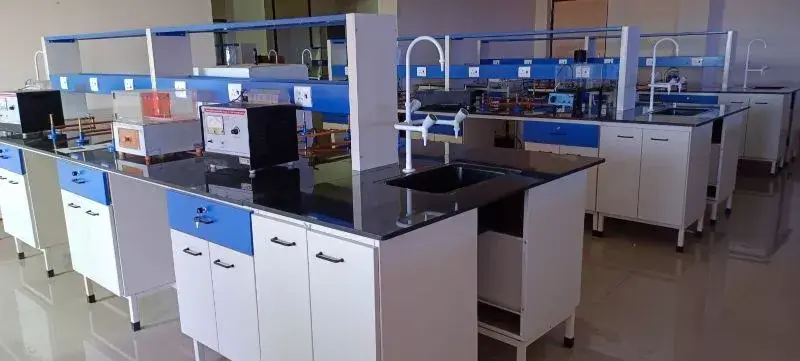When it comes to furniture, the first thing you want to ensure is its durability and budget-friendliness that can meet your requirements. Especially in the case of laboratory furniture, it is important to have the right type of furniture to keep the workspace safe.
So, whether modular or carpenter-made furniture is the right furniture? That is the main question. Though the suitability of furniture for labs depends on several factors, to make your job easy, we have drawn a comparison between modular and carpenter-made furniture in this article.
What is modular furniture?
Modular furniture is a collection of pieces arranged in many ways to meet your needs. They are pre-made units ready to be assembled on-site. You can dismantle it and reconstruct or refit it as required. You can also replace the sections of modular furniture.
Modular furniture advantages
- Gives you privacy without isolation: With modular furniture, you can achieve personal space by attaching furniture to walls, which is impossible otherwise.
- Personalization: You can combine several types of modular furniture in many ways and modify the layout when necessary.
- More flexibility: The space requirements increase as the business expands. The fixed furniture does not allow such flexibility.
- Easy Mobility: Moving furniture components within a building or to another place is simple, thanks to modular furniture.
- It saves money: Modular furniture can save you money by requiring less space, providing greater flexibility and future options, and reducing rental and heating/cooling costs.
- \”Future-proof\” space: Modular furniture allows the space to change along with the times because cultures, workplaces, and technologies constantly alter.
- Waste reduction: Modular solutions are environmentally friendly, providing scope for recycling and reusing material.
What is Carpenter Made Furniture?
Carpenter-made furniture is built by a skilled carpenter or woodworking professional following traditional furniture-making methods, i.e., manually measuring, cutting and finishing processes.
Wood is the typical material carpenters use; however, it can also be made using metal and other materials. Tables, chairs, cabinets, bookcases, and beds are standard carpenters-built furniture.
Modular Furniture vs. Carpenter Made Furniture: A Simple Comparison
| Modular furniture | Carpenter made furniture |
| It can be dismantled and reassembled. | There is no flexibility in disassembling and reassembling. |
| It is machine-made with great precision and a superb finish. | Given that it is handmade, it is not as flawless as modular furniture. |
| Only assembling is done at the site | The entire work is done at the site |
| Minimal cost changes | The price of carpenters keeps changing. |
| Requires a shorter time frame for completion | It takes a longer time frame for completion |
| 3D visualization is possible | Not possible to have 3D visualization |
| Easy cleaning and maintenance | Not as easy as modular furniture |
Compared to carpenters-built furniture, modular furniture is more expensive. However, modular furniture designs can be modified according to your budget. As a result, you can select the options that best fit your budget. At the same time, carpenter-made furniture may also prove expensive as it requires more labor and expertise.
As per the user experience, carpenter-made furniture is said to have more extended durability than modular furniture. Quality raw materials and professional craftsmanship make carpenter-built furniture more durable and reliable than pieces made out of machines.
Modular Furniture for Laboratories

Modular furniture is usually made from high-quality materials that can withstand the harsh conditions of a laboratory environment. And it is also easy to install, which means less downtime for lab operations.
If you are looking for lab furniture that is pocket-friendly and easy to adopt, you can consider modular lab furniture over traditional carpentry furniture. Most importantly, the modular lab furniture complies with all industry safety standards.
Conclusion
In conclusion, modular and carpenter-made furniture are both good materials with pros and cons. Ultimately, it depends on individual needs and budget based on which one should decide the furniture type for their labs.
However, considering the harsh conditions in the labs, modular furniture could be a better alternative. Additionally, easy maintenance and flexibility also make it a more suitable option.
If you are still puzzled about making the right choice, you can reach out to a professional interior designer or skilled carpenter.
Frequently Asked Questions
-
What wood is used in modular furniture?
Plywood is a popular material for modular furniture because it is relatively cheaper and lightweight. Solid wood is another furniture material known for its natural beauty and durability. However, it is relatively more expensive than other materials.
-
How easy is it to assemble and disassemble modular furniture?
Modular furniture is specifically designed to be easily assembled and disassembled. Therefore, assembling or disassembling is quick and simple, even for people with less experience in furniture assembly.
-
What is the lifespan of modular furniture compared to traditional furniture?
Modular furniture made with high-quality material can last as long as traditional furniture. Its flexibility and adaptability sometimes make it more durable than traditional furniture.
-
Are there any environmental benefits to using modular furniture?
As compared to traditional furniture, modular furniture is relatively more environmentally friendly. They use less building material and reduce waste. Additionally, the materials used in the process are recyclable and reusable.



